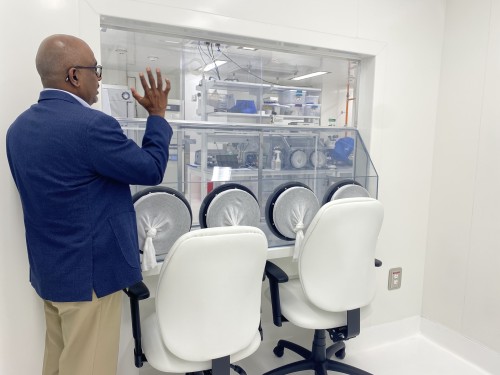Dr. Thangamani's Pre-Clinical Testing Lab: A Beacon of Expertise in Central New York
Driven by a commitment to excellence and with unparalleled expertise in tick-borne disease research, Saravanan Thangamani, PhD a professor of Microbiology and Immunology at Upstate serves as the director of the Upstate Vector Biocontainment Lab, a unique resource in central New York. Dr. Thangamani's laboratory is equipped with BSL-1, -2, and -3 capabilities, a human challenge room for natural disease transmission, and cutting-edge RNA extraction robots that have significantly reduced tick testing time. With these resources at their disposal, the lab plays a pivotal role in pre-clinical testing and can assist pharmaceutical companies in collecting essential data and identifying products that have the potential to progress to human trials.

Saravanan Thanamani, PhD shows off the human challenge room in the Upstate Vector Biocontainment Laboratory.
"Only about 10% of pre-clinical studies will actually move forward [to human trials], but that 90% needs to be identified, right? And that's where we come into play," explains Dr. Thangamani. "I think that it's a niche opportunity. We are positioned in central New York as the only containment lab to offer these services."
Dr. Thangamani highlights his lab’s critical role in assuring patients’ safety. "I think as scientists, we need to do our due diligence before it goes to humans because, yes, the humans are volunteers at the beginning, but you need to make sure even the volunteers get a product that doesn't give them side effects or unintended effects." By meticulously testing the safety and efficacy of therapeutics and drugs in small animal models, Dr. Thangamani's lab ensures that potential risks and adverse effects are identified and addressed before human trials commence.
The Vector Biocontainment Laboratory’s expertise encompasses evaluations of therapeutics and drugs designed to combat viruses, bacteria, and protozoal agents like malaria or babesia. Their capabilities include small animal models, in vitro models, and even arthropod models such as ticks and mosquitoes. This breadth of expertise enables the lab to address a wide range of industry needs and provide comprehensive testing solutions.
His lab’s understanding of the intricate nuances of animal models and their ability to accurately mimic human conditions make them an attractive choice for industry partners seeking reliable and relevant pre-clinical testing. "For a particular type of virus, I know exactly what animal model I should give and what kind of dose I should give and where I should be injecting the virus in the animal so that they will mimic human conditions,” he explains. “If it doesn't mimic human conditions, there is no point in working with it. That is one reason why people want to come to us, because of that expertise."
Dr. Thangamani acknowledges the significance of their work in the broader context of pharmaceutical development. "We know that what we do is a small but important step for the pharmaceutical companies; we do that foundational decision-making. We provide that data so that they can decide; will it be the 10% that goes to humans or is it one of the things that we don't want to waste our time and money on. They can then use their funding and resources in a more efficient way, focusing on what truly matters and triaging what is not essential.”
The Vector Containment Laboratory is a testament to Dr. Thangamani's expertise and dedication to disease research. With its unique capabilities, state-of-the-art facilities, and profound understanding of animal models, the lab has positioned itself as a prominent institution in Central New York. By offering essential pre-clinical testing services and enabling informed decision-making, Dr. Thangamani's lab plays a vital role in advancing medical science and ensuring the safety and efficacy of future pharmaceutical breakthroughs.